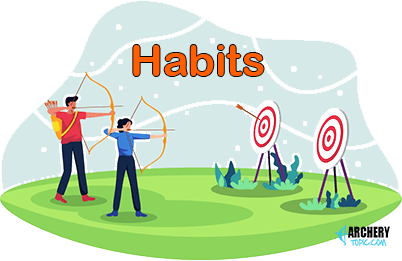If you’re finding out how to aim a recurve bow without sights, you need to master instinctive archery and other sightless aiming methods.
You’ll learn how to master instinctive archery and the gap-shooting method of aiming without sight.
The article also covers essential aspects of instinctive archery that anyone aspiring to shoot without sight would benefit from.
Instinctive Archery
What is Instinctive Archery?

Archers disagree on what instinctive archery is or whether there should be any such concept as instinctive archery.
There are two main views about instinctive archery:
But for the sake of this article, I’ll maintain that instinctive archery is real and can be defined and learned.
Instinctive archery is the use of your subconscious mind to guide all your actions when shooting a bow.
How To Shoot Instinctive Archery (Step By Step)
All the preconditions of effective archery apply to instinctive archery as well.
Preparation:
Additionally, you should be able to judge the distance between you and a target.
Once you’re able to instill these into your psychology, shooting fast and accurately without sight becomes easy.
Step 1: Get the Right Bow

Via aliexpress.com
You can’t be your best at instinctive archery without training with the right bow.
It boils down to draw-length and eye dominance.
Practicing with the wrong bow for your body frame will make it very difficult to shoot accurately, especially when you aren’t using sights.
Step 2: Practice Good Form

The form is vital in shooting accurately. You need an expert or a coach to learn good form.
Once you feel how good form feels, you can set out to practice on your own.
Practice your form repeatedly until it becomes natural to perform on impulse, and use the suitable perch to practice.
If you feel the form isn’t correct or shaky, lower the bow to rest, then draw a new shot.
Practice until you feel confident you’ve mastered it, then practice some more.
Step 3: Learn Other Fundamentals
It’s crucial to figure out your anchor point and learn how to release an arrow the right way.
A rough release can cause you to miss your targets.
A high anchor point like the eye or cheekbone will easier bring the arrow into your line of sight.
Step 4: Engage in Target Practice
Practice first with a large target and get very close to it, ideally 5 yards away, such that it's near impossible to miss.
Standing far, say beyond 10 yards, will likely require you to raise the arrow beyond your natural line of vision.
Getting too close, say 3 yards, puts the arrow below your natural line of vision, requiring you to level it.
The tiny spot helps to drop the arrow well below your line of sight.
Step 5: Aim small

Alternatively, you can use a smaller target than the white sheet. Smaller targets are more accessible to focus on than one spot on a bigger target.
If you aim small, you miss small, and you’ll feel a lot better hitting a target from close than missing from far.
Zero in on your target “while drawing” the bow until you reach anchor, pause for just a split second, then release. You can also first look at the target before drawing to the anchor.
To shoot quickly and accurately, you should develop a rhythm for bringing focus and form together at a precise moment.
Focus develops before the draw and peaks at anchor.
With constant practice, the acts of focusing, drawing, anchoring, and aiming become simultaneous.
Releasing the shot as soon as you hit anchor tends to be more accurate than holding it and psyching yourself out.
Step 6: Make it Consistent and Repetitive
Your grip, anchor point, draw weight, release, form, etc., should be consistent and thoughtless until it becomes automatic.
Besides mastering the basics such as form, grip, etc., consistency and repetition is the key to mastering instinctive archery.
Why Instinctive Archery?
Many people have problems aiming accurately in traditional archery with sights, clickers, and fancy gadgets.
Archery is useless if you can't aim correctly.
Although it isn’t necessary to be accurate with a traditional bow before hunting – because you could use a compound bow etc. – it pays to know how to shoot with all kinds of bows.
If you can shoot instinctively, you can shoot any kind of bow because instinctive archery is the complete kind of archery.
How To Improve Instinctive Archery:

To develop this skill correctly, you need to understand some fundamentals and take care of certain prerequisites.
Understanding these fundamental concepts will guide your actions and make it easier to master instinctive archery.
So what is this fundamental concept or psychology behind instinctive archery?
The key lies in understanding how the subconscious mind works and applying this knowledge to develop your instinctive archery skills.
Our brain is very complex, but we have a lot of power over its programming.
The subconscious mind is a "huge" memory bank with an unlimited capacity.
The subconscious mind stores everything ever happened to you and allowed you to remember events 50 years ago.
Our subconscious mind ensures that your body responds precisely how it's programmed while also allowing you to store and retrieve data.
The subconscious mind receives its commands from your conscious mind.
It works non-stop to ensure that your behavior and actions follow a pattern consistent with your thoughts, bow-shooting actions/experiences, hopes, and desires.
The subconscious mind memorizes the actions you repeat "over and over again,” which becomes your "habit.”
So, if you want to shoot a bow instinctively and accurately, you must tell this to your subconscious mind so that it will guide your muscles and brain during archery.
And there are two keys to achieving this:
Shoot with a consistent but correct form, draw length, anchor point, etc., until you master it, and do this repeatedly.
When an action is consistent and repetitive, your subconscious mind records it and transfers that message to your mind whenever the need arises.
It’ll record your form, draw length, the gap at certain distances, etc.
Through a concept known as “muscle memory,” the subconscious mind makes you feel it immediately when something isn’t right.
It like when you pull with the wrong draw length, form, etc.
The Argument Against Instinctive Archery

When someone mentions instinctive shooting, the layman tends to think of shooting out of a sudden reaction.
This understanding derives from the literal meaning of the word “instinctive,” and it's perfectly understandable.
The difference is, instinct is something inert that we are born with, while instinctive archery is learning how. It worked.
Instintive vs gap shooting
Some archers argue that because everything happens so fast, many people think that instinctive shooting doesn't involve aiming.
They believe that only gap shooting and similar techniques involve aiming.
These archers identify some significant similarities between gap shooting and instinctive shooting, making them almost identical but for a few often overlooked differences.
They contend that instinctive shooting involves aiming, but a "subconscious aiming", while gap shooting uses "conscious aiming".
The argument recalls that it takes time and practice to perfect the so-called instinctive shooting skills, but instincts aren’t developed through physical activity.
Focus
When you aim at a bow, all your focus is on the spot you want to hit, but the sight picture (everything in your view when shooting a bow) is in your peripheral view.
Sight picture includes your bow, arrow, bow hand, the larger target, scenery, etc.
The farther anything is from your point of focus, the blurrier it appears. To illustrate this, focus on the first few words of this line you are reading now.
You'll notice that only the first 1 - 3 words are clear to you. All the words above, below, or in front of these few words are blurry and illegible - until your focus reaches them.
But you're aware that these blurry words exist. That's because they are within range of your peripheral view.
The same thing happens when you aim a bow.
The spot you want to hit is your primary focus. Everything else appears in your peripheral view, including the arrow tip.
The sight picture helps you line up the shot by compensating for the lack of a shifting aid.
Try shooting in darkness

To appreciate the importance of the sight picture, try shooting at an object, like a glow stick or laser pointer, in the pitch dark.
You can't see your hands, arrow, bow, or any other thing except for the glowing target in pitch dark.
Your shot won't be accurate, and you'll find yourself consciously looking for something to line up your shot.
That tells us that without the sight picture, you cannot shoot accurately.
It follows that even in instinctive archery, some aiming still takes place. But because things happen so fast, you won't even notice it.
The Argument for Instinctive Shooting

Archers who accept the concept of instinctive archery believe that there’s an instinctive element in shooting a bow – particularly a traditional bow.
But their definition of instinctive archer varies from the literal meaning of the word “instinctive”.
Instinctive archery is the use of your subconscious mind to guide all your actions while shooting a bow.
Aiming occurs but so fast that you won’t take notice. Because unlike using sight or conscious aiming methods, the aiming in instinctive archery comes from the subconscious mind.
Aiming methods like gap shooting and string-walking are conscious actions, but they do have elements of unconsciousness.
For example, you’ll trust your mind and sight to measure the gap and distance from your target, and these come from the subconscious mind.
Understanding how the subconscious mind works is important to master this skill. Your body and brain rely on the subconscious for guidance when shooting.
Pro Tips:
Remember that 90% of shooting is at first physical, then it goes to 90% mental.
Ignore accuracy at first. Get every aspect of your shooting under control except aiming.
Don’t consciously try to line up your shot by looking at the arrowhead and target.
Focus on the target, get to your anchor point, and trust your brain to do the rest.
When you sight a target, there is that intense short moment when the focus is sharp. Practice shooting that very moment without focusing for long.
Look past the arrow and don’t think about it. If your mind is wondering about the arrow, let down your bow and don’t shoot. Then try to get back in control.
But despite the importance of mastering snap shooting, be careful not to develop target panic as a result of inadequate fundamentals or sudden release.
Before using a sightless recurve or longbow, practice with a compound or recurve that has a definite draw length so that your body can develop a feel of just when a draw is right.
Instinctive shooting can be fast, but don’t consciously try to shoot quickly.
Release a shot as soon as you feel ready, and don’t hesitate.
Inaccuracy results from poor fundamentals (like poor form, rough release) or focuses panic.
With time, your body and movements will make the adjustments as soon as you’re focused on a target.
It is possible to figure out the angle of trajectory of your bow and understand the arrow’s flight so that you can calculate the arrow angle necessary for any shot.
Avoid foreground and background clutter.
It’s also very important to trust in yourself to hit the target. It paves the way for your instincts to take over.
When the arrow leaves your bow, do not lower the bow until the arrow is long gone.
Gap Shooting Method
What Is The Shooting Gap?
Gap shooting is a method of aiming developed and employed by archers who don't use a sight.
These archers use the arrowhead as a reference point to a target.
According to how far you are from it, it’s a technique of aiming below, above, or right on the target.
Anyone can learn gap shooting if they follow the methodological learning process. It starts with finding your gap.
How To Start Gap Shooting (Step By Step):
Step 1
Set the stage using a target box of 80cm or so and a peg. Set the box vertically erect and place the peg at the bottom of the base. The peg is your target.
Step 2
Stand 5 yards from the target and shoot three arrows aimed at the peg. The arrows will hit slightly above the peg.
Step 3
Measure how far above the peg, and that is your gap at 5 yards.
Repeat the same process from 10 yards, 15, 20, etc., to find your gap at such distances.
Step 4
After finding your gap, you should learn to estimate distance by just looking and applying your gap at that distance.
Repeat this action repeatedly for these distances until you can confidently estimate the distance from a target without measurement.
When repeating your actions, aim below the target some inches according to your distance from it.
If you estimate the distance from a target to 20 yards, then your gap at 20 yards applies. And so on.
Pro Tips:
Conclusion
You’ve learned about instinctive archery, the arguments about it, and why and how to employ it.
Hopefully, you now have a better understanding of how to aim a recurve bow without sights.
You’ll find yourself in different situations when hunting.
Sometimes you have the opportunity to aim, but other times you just need to shoot within five seconds of seeing a game.
Learning instinctive archery comes with other advantages like making you a more accomplished archer.
Letting you shoot with all kinds of bows, and giving you a greater satisfaction from nailing your target without the aid of sights.
You’re always welcome to ask any questions or share your opinion in the comments.
